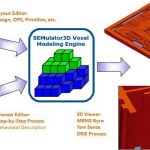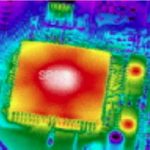The design and manufacture of MEMS is very different and in many ways more complex process than even the most advanced ICs. MEMS involve multiple degrees of freedom (i.e. the device to exhibit different characteristics under different physical state, motion or mechanics), making fabrication of MEMS extremely complex; and hence the processes are highly customized and typically linked to particular design or device. The process flow and design parameters are highly sensitive to each other, thus requiring multiple build-and-test cycles and longer MEMS process learning cycles. And these days most of electronic devices or semiconductor designs involve MEMS integrated into them, necessitating a MEMS+IC design approach. For example, gyroscopes are being used in smartphones in big way to enhance motion detection and orientation. Given the cut-throat competition in the mobile market, with increasing feature sets and shrinking windows of opportunity, it’s critical that process learning cycles for MEMS development move from time-consuming build-and-test methods to more efficient methodologies to streamline the handoff from design to manufacturing.
The good news is that Coventor’sSEMulator3D tool (about which I had earlier talked in the context of Virtual Fabrication Platform for semiconductor design ICs) is providing an excellent platform for virtual modeling of MEMSas well. Physical data (such as capacitance) can be extracted from the model for quantitative analysis and process variation studied to quickly predict the exact model of interest before actual fabrication, thus reducing the learning cycle for MEMS technology.
[SEMulator3D Virtual Fabrication Platform]
SEMulator3D takes the design layout data and unit process behavioral description as input and produces the 3D model, from which physical data can be extracted for quantitative analysis.
Coventor, in the latest in its series of informative whitepapers, has demonstrated in great detail how SEMulator3D can develop a model for a 3-axis gyroscope as used by Applein its iPhone4 (publicly available here).
[a) SEMUlator3D final model of 3-axis gyroscope, b) Close up of a device corner]
[Model output after a) Release oxide deposition, b) via to electrode, c) Epitaxial polysilicon growth and planarization, d) DRIE, e) Release]
The above images show step-by-step process flow development. The epitaxial polysilicon device layer is patterned using DRIE and sacrificial release oxide layer is removed to release the device. For developing gyroscope comb fingers, different DRIE process set-points were evaluated with SEMulator3D’s Expeditor tool running an automated DOE with polymer deposition thickness ratio, silicon lateral etch ratio and polymer etch ratio as parameters. It has been observed that the top CD is more sensitive to the polymer thickness ratio when both the lateral etch ratio and the polymer thickness ratio increase. However high lateral etch and polymer etch ratio removes enough of thick polymer to keep the sidewall vertical. With thinner polymer the sidewall can become slanting.
Interestingly, the device operating window can also be determined by estimating and computing the electrostatic parameters. The capacitance between the gyroscope’s comb drive actuators (patterned with DRIE) can be determined by meshing the 3D model and running a field solver on the mesh.
[Capacitance extraction by meshing – a) Stator and Rotor fingers, b) Straight sidewalls, c) DRIE scalloped sidewalls. d) Computed results through field solver]
The above images show how the capacitance of one portion of the comb drive actuator is evaluated. Initially the capacitance is estimated based on parallel plate capacitance resulting from finger overlap and then meshing was done, first with straight sidewalls and then with scalloped sidewalls due to DRIE.
SEMUlator3D has recently added a very important state-of-the-art feature, ‘Structure Search’ that evaluates the entire 3D model to detect any structural violation, thus eliminating time-consuming destructive analysis to locate such failures. In the gyroscope model, Structure Search was used to locate the release oxide residues that could affect device performance (as the residual oxide can induce dielectric between the proof mass and the electrode, thus altering capacitance and limiting maximum out-of-place deflection of the mass) and yield.
[Residue oxide – a) between widely spaced release holes, b) near device-to-ground vias, resulting from lithographic overlay variation due to shifted masks, c) clean without residue]
In the above images, oxide residue locations are marked in blue color dots underneath a transparent device layer. The residues near vias can cause significant parasitic capacitance in the region and hence acceptable tolerance in mask placement must be estimated by this method.
SEMulator3D 2013 provides an excellent platform for cost effective, fast and accurate model development of MEMS before fabrication, thus eliminating costly build-and-test cycles through the wafer production process. SEMulator3D’s advanced modeling capabilities provide accuracy of prediction in the final model for production to enable a higher yield than manual approaches. The whitepaperposted at Coventor website provides more depth of details. It’s interesting to read and enhance knowledge in these new trends and methods in MEMS and semiconductor manufacturing.
More Articles by Pawan Fangaria…..
lang: en_US







